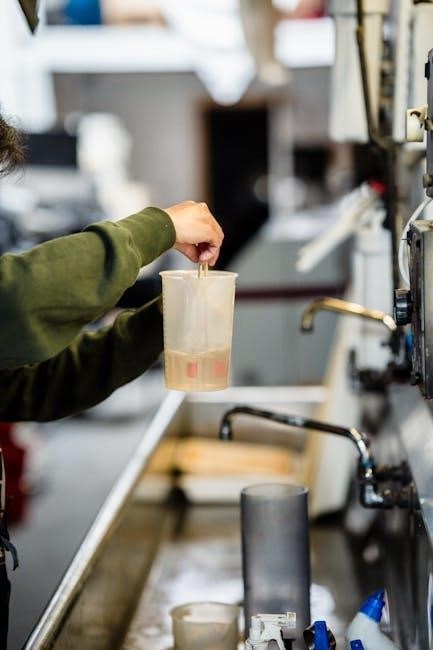Manual Chemistry Laboratory: A Comprehensive Guide
A manual chemistry laboratory is a dedicated space equipped for scientific experiments, observations, and science education․ It houses essential tools and equipment for conducting experiments, analyzing data, and ensuring accuracy in chemical investigations․
The manual chemistry laboratory serves as a cornerstone for scientific exploration and learning, providing a hands-on environment for students, educators, and researchers․ It is a dedicated space meticulously equipped with various tools, instruments, and apparatus, enabling the execution of experiments, data collection, and analysis․
Within this laboratory setting, individuals can engage in practical investigations, fostering a deeper understanding of chemical principles and phenomena․ The manual aspect emphasizes the importance of direct interaction with equipment and chemicals, promoting skill development and critical thinking․ Safety protocols and personal protective equipment (PPE) are paramount, ensuring a secure environment for experimentation․
The laboratory’s comprehensive equipment list, including glassware, heating devices, measurement tools, and analytical instruments, supports a wide range of chemical studies․
Essential Equipment: Glassware
Glassware forms the backbone of any manual chemistry laboratory, serving as essential containers and tools for a multitude of experiments and procedures․ From holding and mixing chemicals to precise measurements and reactions, glassware’s inert nature and transparency make it indispensable․ Beakers, with their cylindrical shape and flat bottom, are versatile for general-purpose use, while flasks, including Erlenmeyer and volumetric types, cater to specific needs like swirling and accurate volume preparation․
Test tubes, small and cylindrical, are ideal for conducting small-scale reactions․ Graduated cylinders offer precise volume measurements, while burets are crucial for accurate liquid dispensing in titrations․ Pipettes, available in various forms, facilitate the transfer of specific liquid volumes․ Proper handling, cleaning, and storage of glassware are vital for maintaining accuracy and preventing contamination in experiments․
Beakers and Flasks
Beakers and flasks represent fundamental glassware in a chemistry laboratory, each serving distinct purposes․ Beakers, typically cylindrical with a flat bottom and a lip for pouring, are versatile containers for holding, mixing, and heating liquids․ Their wide mouths facilitate easy access and manipulation of contents․ Flasks, on the other hand, come in various shapes tailored to specific applications․
Erlenmeyer flasks, with their conical shape, are ideal for swirling liquids without spillage․ Volumetric flasks, characterized by a long neck and a calibration mark, are designed for preparing solutions of precise volumes․ Both beakers and flasks are available in various sizes and materials, allowing chemists to select the appropriate vessel for their experimental needs․ Their proper use and cleaning are vital for accurate and reliable results․
Test Tubes and Graduated Cylinders
Test tubes and graduated cylinders are indispensable tools in a chemistry laboratory, each serving distinct yet crucial roles․ Test tubes, small cylindrical vessels typically made of glass or plastic, are primarily used for holding, mixing, and heating small quantities of liquids or solids during experiments․ Their compact size and rounded bottoms make them convenient for various chemical reactions and observations․
Graduated cylinders, on the other hand, are designed for accurately measuring the volume of liquids․ These cylindrical vessels feature a narrow shape and clear markings along their sides, allowing for precise readings of liquid levels․ Graduated cylinders are available in various sizes, catering to different volume requirements․ While not suitable for heating or mixing, they provide essential measurements for quantitative experiments and solution preparation․ Proper handling and careful meniscus reading are crucial for accurate volume determination․
Burets and Pipettes
Burets and pipettes are essential volumetric glassware used in chemistry laboratories for the precise measurement and dispensing of liquids․ Burets are long, graduated tubes with a stopcock at the bottom, designed for delivering variable volumes of liquids with high accuracy․ They are commonly used in titrations to gradually add a reagent until a reaction reaches its endpoint, allowing for precise quantitative analysis․
Pipettes, available in various types such as graduated, volumetric, and Pasteur pipettes, are used for transferring specific volumes of liquids․ Volumetric pipettes are designed to deliver a single, precise volume, while graduated pipettes allow for dispensing variable volumes․ Pasteur pipettes, typically made of glass or plastic, are used for transferring small, non-critical volumes of liquids․ Proper technique is essential for accurate measurements with both burets and pipettes․
Essential Equipment: Heating and Mixing
Heating and mixing are fundamental processes in a chemistry laboratory, requiring specialized equipment to ensure controlled and efficient reactions․ Bunsen burners are a common heat source, producing an open gas flame used for heating, sterilizing, and combustion․ Hot plates provide a safer, more uniform heating surface, ideal for heating flammable substances or maintaining consistent temperatures․
Stirrers, both magnetic and mechanical, are essential for mixing solutions․ Magnetic stirrers use a rotating magnetic field to spin a stir bar within a liquid, ensuring thorough mixing․ Mechanical stirrers employ an overhead motor to drive a stirring rod, suitable for viscous or large-volume solutions․ These tools are crucial for maintaining homogeneity and facilitating chemical reactions․
Bunsen Burners
The Bunsen burner, a staple in chemistry laboratories, provides a single open gas flame for heating, sterilization, and combustion․ Composed of a metal tube connected to a gas source, it allows adjustable airflow, controlling flame temperature and characteristics․ Proper use involves lighting the burner with a striker and adjusting the air valve to achieve a blue, non-luminous flame for optimal heating․
Safety precautions are paramount when operating a Bunsen burner․ Keep flammable materials away, never leave it unattended, and ensure proper ventilation․ Regular inspection of gas lines and connections prevents leaks․ Understanding flame adjustment techniques ensures efficient heating while minimizing the risk of accidents․ The Bunsen burner remains a versatile tool for various heating applications․
Hot Plates and Stirrers
Hot plates provide a controlled heating surface for laboratory experiments, offering an alternative to open flames․ They typically feature adjustable temperature controls, ensuring precise heating for various applications․ Magnetic stirrers, often integrated with hot plates, use a rotating magnet to stir liquids, promoting uniform mixing and dissolution․ These stirrers employ a stir bar placed inside the solution․
The combination of hot plates and stirrers is invaluable for preparing solutions, heating reactions, and maintaining consistent temperatures․ When using hot plates, ensure proper grounding and avoid heating flammable substances․ Magnetic stirrers should be used with appropriately sized stir bars․ Clean up spills immediately to prevent damage․ These tools are essential for controlled heating and mixing․
Essential Equipment: Measurement and Analysis
Accurate measurement and analysis are fundamental to chemistry, requiring specialized equipment․ Balances are essential for determining the mass of substances, providing precise measurements critical for stoichiometric calculations and solution preparation․ pH meters measure the acidity or alkalinity of solutions, vital for reaction monitoring and environmental analysis․ These meters utilize electrodes to detect hydrogen ion concentration, providing a digital readout․
Spectrophotometers analyze the interaction of light with matter, enabling the identification and quantification of substances․ Titration equipment, including burets and indicators, is used to determine the concentration of solutions through controlled reactions․ Proper calibration and maintenance of these instruments are essential for reliable results․ Accurate measurements form the cornerstone of chemical experiments․
Balances
Balances are indispensable tools in a chemistry laboratory, used for accurately measuring the mass of substances․ Precision balances, capable of measuring to the milligram level, are essential for quantitative analysis and precise reagent preparation․ Analytical balances offer even higher accuracy, measuring to the microgram level, critical for research and advanced experiments․
When using balances, it’s crucial to ensure they are level and calibrated regularly using standard weights․ Samples should be placed in the center of the weighing pan to minimize errors․ Tare the balance before each measurement to zero out the weight of containers․ Proper technique and maintenance ensure reliable and accurate mass measurements․
pH Meters
pH meters are vital instruments in a chemistry laboratory, used to measure the acidity or alkalinity of a solution․ These meters determine the hydrogen ion concentration, providing a quantitative measure of pH․ Accurate pH measurements are crucial in various chemical reactions, titrations, and biological studies․
A pH meter consists of a probe that is dipped into the solution, and a meter that displays the pH value․ Regular calibration with standard buffer solutions (pH 4, 7, and 10) is essential for accurate readings․ The electrode should be rinsed with distilled water between measurements to avoid contamination․ Proper maintenance ensures the longevity and reliability of the instrument․

Safety Equipment and Procedures
Maintaining a safe environment in a chemistry laboratory is paramount to prevent accidents and protect personnel․ This involves the use of appropriate safety equipment and adherence to established safety procedures․ Proper training and awareness are crucial to ensure that everyone understands and follows these guidelines․
Safety protocols include the correct usage of personal protective equipment (PPE), such as safety goggles, gloves, and lab coats․ Safe handling of chemicals, proper waste disposal, and knowledge of emergency procedures are essential․ Regular safety drills and inspections help reinforce these practices and identify potential hazards․ A well-organized lab with clear signage contributes to a safer working environment․
Personal Protective Equipment (PPE)
Personal Protective Equipment (PPE) is crucial for minimizing risks in a chemistry laboratory․ Safety goggles are essential to protect eyes from chemical splashes or projectiles․ Lab coats shield skin and clothing from corrosive substances․ Gloves protect hands during chemical handling and prevent skin contact․
Selection of appropriate PPE depends on the chemicals and procedures involved․ Ensure a proper fit for effective protection․ Regularly inspect PPE for damage and replace when necessary․ Proper storage and maintenance of PPE are vital․ Adequate training on the use of PPE is crucial for all laboratory personnel․ Consistent use of PPE significantly reduces the likelihood of accidents and injuries․

Safe Handling of Chemicals
Safe handling of chemicals is paramount in a chemistry laboratory to prevent accidents․ Always read and understand the label and Safety Data Sheet (SDS) before using any chemical․ Use appropriate personal protective equipment (PPE), including gloves, goggles, and lab coats․ Work in a well-ventilated area, preferably under a fume hood, to avoid inhalation of hazardous vapors․
Avoid direct contact with chemicals; use tools such as spatulas or pipettes․ Never eat, drink, or smoke in the laboratory․ When mixing chemicals, always add concentrated acid to water slowly and carefully․ Properly label all containers with the chemical name, concentration, and date․ Store chemicals in designated areas, following compatibility guidelines to prevent hazardous reactions․
Leave a Reply
You must be logged in to post a comment.